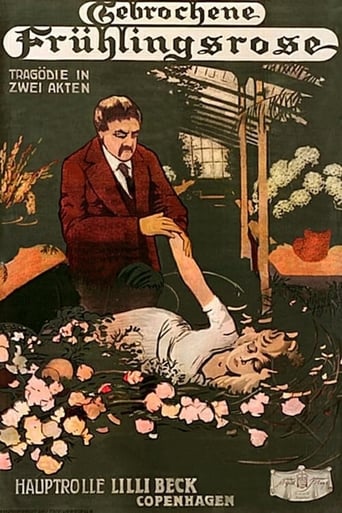Cineanalyst
1912 was an inaugural year in the history of Swedish cinema. Charles Magnusson, heading the newly formed studio Swedish Biograph (Svenska Biografteatern)—later to become the Swedish Film Industry (Svensk Filmindustri)—recruited from the theatre the two men who would be the leading filmmakers of Sweden's silent era golden age, Victor Sjöström and Mauritz Stiller. Among their first films was this one, which is known by a few different English translations: "The Gardener", "The Broken Spring Rose", "The Cruelty of the World". Stiller wrote the scenario, and Sjöström was the director and starred as the villain. Additionally, the great cinematographer of this era, Julius Jaenzon, photographed it.Although I am very happy to have seen this early feature, which I thought I would only ever be able to read about and see clips of in documentaries, the viewing experience was far from ideal. I saw it via YouTube and without a musical score. Based on apparent artifacts, the source was likely a video transfer. The frame rate was much too fast (although that may not be the worst thing for a longer film from this period, most of which tended to be static and plodding), which in addition to the lost footage resulted in a shortened runtime of 23 minutes. According to John Fullerton in his essay "Spatial and Temporal Articulation in Pre-classical Swedish Film", printed in the anthology book "Early Cinema: Space, Frame, Narrative", "The Gardener" is a three-reel film. But, considering that the film was originally banned in Sweden and had been considered lost until a censored American print was rediscovered in 1979, we should be thankful it's accessible in any form.Due to this being a censored version and the apparent missing footage (the numbered title cards demonstrate that some are missing), the story wouldn't have made much sense to me without the descriptions given by historians, such as the one delivered in the second episode, "Art's Promise Land", of the excellent documentary series "Cinema Europe: The Other Hollywood" (1995). Based on those descriptions, in the film, a boy and girl's romance is broken up by the boy's father (played by Sjöström), who orders the boy to leave town. Apparently, it turns out, this was a ploy for the father to rape the girl. In this censored American print, the rape scene shows (through some decent, if brief, continuity and background-to-foreground action, by the way) the man chasing the girl through his tea garden. When we next see the girl, she is clearly distressed. (Although I don't know why she looked so happy to begin with in the garden—smiling and smelling plants—when her boyfriend had just been forced to leave, but I digress.) The only other indication of what happened is a title card that sets up the scene with the sole word "Trespassing".Next, the man forces the girl and her father to leave home. Her fate is saved for a time by some generous old man dressed in what appears to be military regalia, but after he dies, she is forced to leave yet another home, which is when she turns to prostitution. There's no direct indication of her being a prostitute in the film, either, but it does explain why she's partying after the recent death of her benefactor and why, after this partying brings her back to the tea garden, she's suddenly overcome by a fit of despair and keels over dead. The picture ends with her rapist discovering her death.Clearly, this is some sensational stuff, which is what the Scandinavian cinema was known for back then. Being such an early film, it doesn't feature the beautiful conflicts with the harsh antagonistic Nordic outdoors that Sjöström and Stiller's later work display, such as in "Terje Vigen" (1917), "The Outlaw and His Wife" (1918), "Sir Arne's Treasure" (1919) and "Johan" (1921). The other IMDb reviewer here, Mike Boxham, is surely right in seeing classism as the central theme of the film, and, in that respect, it's more closely related to Sjöström's other available early feature, "Ingeborg Holm" (1913). "The Gardener" follows the dated tableau style, or the tell-then-show method, of title cards describing proceeding action, so on the level of personal drama, it's also lacking and typical of its age. Nevertheless, Jaenzon's lens did capture some lovely views of and around the lake in the picture—of the couple canoeing—a shot of them atop a hill overlooking a cottage and the body of water. Thus, at the least, they used the Swedish landscape to some effect, if not spectacularly as they became famous for later.
mike bloxham
The Swedish landscape is heartrendingly beautiful in this light-toned silent film. Sjostrom creates a nice little piece, with clear political intent - often missed in commentary inside class-blind USA - sensitively carried by the well-worked plot of maiden's idyll betrayed. The same falls in love with her employer's son, whom his father then sends away, one infers - the audience of the time would at any rate - in order to end the socially inappropriate relationship, but in fact so that he may use his power to take advantage of her, by force. She and her aged father are summarily dismissed; taken in by a wealthy patron, when he dies his family casts her out, into the demimonde (note her cigarette!) of the overclass' student life. A final set piece has her body, strewn with thorn roses, accusing the cause of her ruin. The plot is incomplete, and these short moral films are not in fashion now, to say the least; but well worth seeing, in the context of retrospectives of Sjostrom's excellent work.
